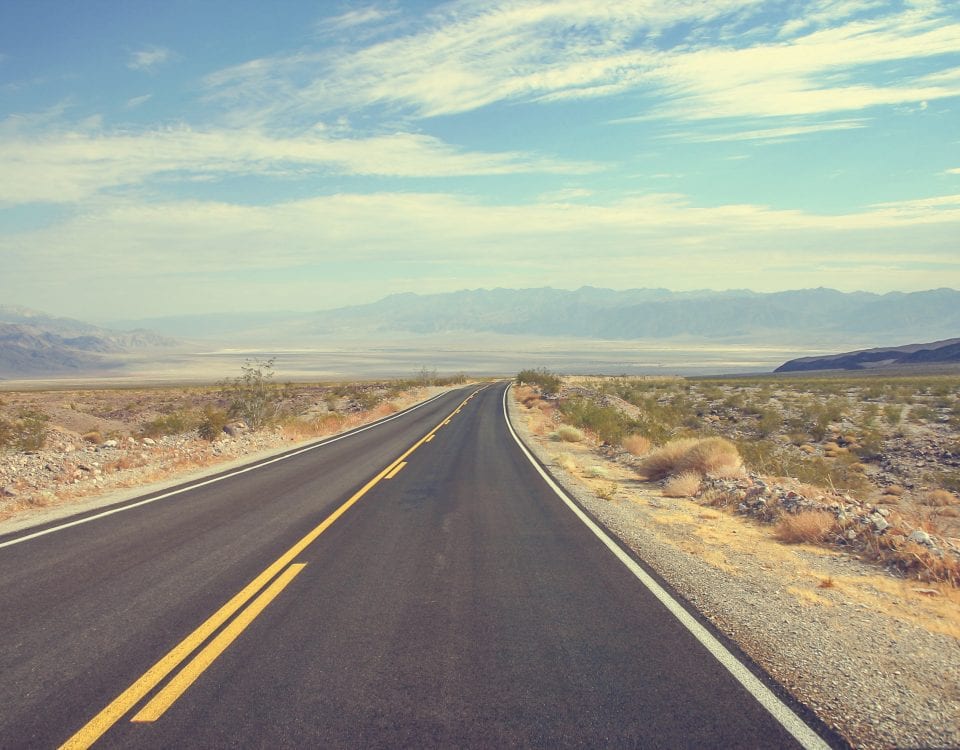
Day 40: From Limestone to Lincoln
April 28, 2021
Day 38: Motoring Toward the Motor City
April 26, 2021Most recently updated on February 9, 2024
Originally posted on April 27, 2021
Today, we transition to a new part of the country.
Before we embark on our journey into the Midwest, however, we have two more industrial towns to visit in Michigan.
We head north out of Detroit on Interstate 75.
As we depart, we pass through Hamtramck, a community of 27,000 that is the virtual meaning of “melting pot” and is now the most diverse city in Michigan.
The town was settled in 1796 by French-Canadian soldier Francois Hamtramck, who later was the commander of Fort Shelby during the War of 1812.
German farmers moved in during the 1800s to make use of the abundant agricultural land. The community was incorporated as a village in 1901 and as a city in 1922.
The Dodge Main automobile manufacturing plant opened here in 1910 and began producing cars in 1914.
A flood of Polish immigrants arrived in the 1920s and 1930s, seeking jobs in the auto industry. At one time, Hamtramck was 75 percent Polish. That segment of the population is now about 10 percent.
That’s because over the past 30 years, Middle East and Asian immigrants from Bangladesh, Yemen, Bosnia and other countries have streamed in.
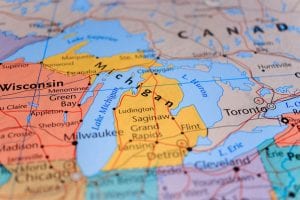
The city is now listed as 54 percent white, 26 percent Asian and 10 percent Black. About 30 languages are spoken here. In 2015, Hamtramck became what is believed to be the first U.S. city to have a majority Muslim city council with 4 of the 6 board members being of the Islam faith. In November 2021, voters elected an all-Muslim city council. The new council members, all of whom are men, as well as Mayor Amer Ghalib, a Muslim who defeated a three-term incumbent, were sworn in during a January 2022 ceremony. The all-Muslim council was retained during the November 2023 election.
You can see the influence of this immigration in many facets of life here.
The city has had a law on books since 2004 that allows for a “call for prayer” on loudspeakers in town up to five times a day.
The council’s Islamic faith also produced a conflict in late 2020 when the city’s first retail marijuana shop opened. Some Muslim leaders, including council members, objected because their religion forbids alcohol, opiates and other substances that alter a person’s mind.
In early December 2020, the council passed a resolution banning any future marijuana shops but not before a second such establishment got its necessary permits and opened in early January 2021. The ban was repealed in late January after a citizen’s petition supporting the shops garnered 500 signatures. There are now four cannabis shops in town.
The council has also ignited controversy over the issue of LGBTQ rights. In July 2023, the council voted to ban Pride flags on city property due to their religious beliefs. The vote was greeted with loud applause from a packed meeting hall. In August 2023, police reported there have been thefts of Pride flags from various homes and businesses. In October 2023, the mayor further ignited the dispute by appearing on a Russian television outlet to explain the council’s decision.
Despite the disagreements, the town does take pride in its diversity. There are signs around the community that proclaim “The World in Two Square Miles.
Hamtramck has had its economic difficulties.
The city has twice gone into emergency financial status. Once in 2010 and again in 2013. The latest restriction was lifted in 2014.
Chrysler closed the Dodge Main plant in 1980 after 70 years of operation.
American Axle shuttered its factory in 2012. The facility once employed 2,200 people. When it closed, 300 jobs were lost. An Islamic center is now in the building.
In 2018, General Motors announced it would be closing its Detroit-Hamtramck Assembly Plant. The complex was built in the 1980s after the city of Detroit and GM used eminent domain to grab 640 acres and demolish 1,500 homes. The factory produced the Chevrolet Volt, Cadillac CT6, Chevy Impala and Buick Lacrosse.
The factory closed in February 2020, resulting in 800 layoffs. However, in early 2021 GM officials began a $2 billion retrofit to create a new “Factory Zero” plant that produces electric cars and trucks. The plant opened in mid-November 2021 with President Joe Biden paying a visit. The company says 2,200 people will be employed once the factory is fully operational.
Those jobs could come in handy in a city whose residents are struggling economically.
The median annual household income in Hamtramck is $39,000. In addition, 37 percent of the city’s residents live below the poverty line.
The median home price is about $155,000. Housing has been an issue in Hamtramck for decades. Before GM demolished homes for their factory, more than 200 houses were torn down to make way for Interstate 75. In 1971, federal judge Damon Keith ordered the city to rebuild 200 homes for families of color. When the judge died at the age of 96 in April 2019, all but three of those homes had been built.
Hamtramck’s economy today relies on manufacturing, retail trade and food services. One of the biggest employers is the Kowalski Sausage Company.
The city has a variety of ethnic restaurants, many of which feature sausage.
Hamtramck does have a handful of famous folks.
One of them is al-Imam Warith Deem Mohammad, who was born here in 1933. Imam Mohammad was elected as the supreme leader of the Nation of Islam in 1975. During his leadership the Five Pillars of Islam was approved. In the 1990s, he became the first Muslim to deliver the invocation to the U.S. Senate.
Rudy Tomjanovich, a basketball star who played and coached with the Houston Rockets in the NBA, was born in Hamtramck.
Singer Mitch Ryder also hails from here. Ryder was a well-known rock musician in the 1960s and 1970s best known for the song “Devil with the Blue Dress On.”
—————————————
It takes another hour on northbound Interstate 75 to get to the city of Flint.
When you hear the word “Flint” today you most likely think of “tainted water.”
However, there are a lot of issues going on in this city of 78,000 residents.
In its first 150 years, Flint was actually quite successful.
It was founded in 1819 by fur trader Jacob Smith. It quickly became a major lumber area on the Saginaw Trail.
In the late 1800s and early 1900s, it was a leading manufacturer of carriages, producing 100,000 of them in 1900. The carriages earned the town the nickname “Vehicle City.”
The community really embellished that moniker when its economy shifted to automobiles. Buick moved here in 1903 and General Motors was founded in Flint in 1908.
The city was the site of the Flint Sit-Down Strike that began on December 30, 1936 at the General Motors Fisher Body Plant Number One. The 44-day protest led to the recognition of the United Auto Workers as the representative for GM employees.
After World War Two, Flint was a major producer of Chevrolets and Buicks.
Then, the wheels came off.
Over the span of three decades, GM downsized its workforce at its Flint facility from a high of 80,000 in 1978 to under 8,000 in 2009. However, GM officials announced in June 2023 that is investing more than $1 billion in their Flint assembly plant as well as a metal manufacturing center to prepare for production of next-generation internal combustion engine heavy-duty trucks.
The city’s population fell more than 50 percent from its peak of 200,000 in 1960. In the process, more than 1,000 homes have been torn down.
Its median annual household income is $35,000 and a third of its population lives in poverty. The median price of a home is less than $60,000.
The city declared a state of financial emergency from 2002 to 2004 and then again from 2011 to 2015.
Then came the kicker.
For the past decade, Flint has been dealing with a public health crisis due to lead contamination in its domestic water. The problem started in April 2014 when local officials in a cost-cutting move temporarily switched the city’s water supply to the Flint River, which has been a source of pollution for more than a century.
Within a month, Flint residents were complaining about brown, odd-smelling water flowing into their homes. Their pleas were mostly ignored as were warnings by doctors of unsafe drinking water. By August, E.coli and coliform bacteria were detected in Flint’s water.
The Environmental Protection Agency sent a memo to the city a few months later warning about dangerous levels of lead in the water. In October 2015, the city switched back to the Detroit water system, but by then damage had already been done to the pipes inside homes. Free water bottles and filters were provided to residents.
In early 2016, the governor declared a state of emergency and brought in National Guard troops to help distribute supplies. President Barack Obama responded by declaring a federal emergency and sent $80 million to help.
However, in late 2016, Flint residents were still using bottled water to cook and drink. The city began replacing the lead pipes in homes. In 2017, residents were told the water in most houses was safe, but many didn’t believe the reports.
In September 2022, state officials announced that 95 percent of lead service pipes had been replaced in Flint, leaving just 1,600 that need replacement. In August 2023, officials reported that Flint’s water met safe drinking water standards for the seventh year in a row.
Nonetheless, officials estimate that 30,000 schoolchildren were exposed through the water to neurotoxins known to have detrimental effects on developing brains and nervous systems. Many Flint parents reported behavioral problems and other issues with their children. The school district revealed that the percentage of students who qualified for special education services had jumped from 15 percent to 28 percent from 2014 to 2019.
In all, the tainted water was linked to 12 deaths and 87 illnesses caused by Legionnaire’s disease.

Residents of Flint, Michigan, complained about odd-colored faucet water at the beginning of the city’s water contamination crisis. Photo by WGVU News.
In November 2019, a class action lawsuit was filed. It stated that 14 officials, including Michigan’s governor and Flint’s mayor at the time, were responsible for providing unsafe drinking water to local residents. A $600 million settlement was reached in August 2020. In March 2023, a judge formally approved the settlement, paving the way for financial distributions to be made.
In January 2021, criminal charges were filed by the Michigan Attorney General’s office against 8 public officials, including former Governor Rick Snyder, for their role in Flint’s water crisis. However, those charges were dismissed by a Michigan judge in December 2022 due to procedural errors.
Flint is not the only city dealing with water quality issues. We saw that when we visited the Love Canal neighborhood near Buffalo, New York, on Day 33.
In fact, a February 2020 article in Time magazine reported that 30 million Americans live in areas where water systems violate safety rules. The problems these communities face range from aging water pipes to industrial pollution to uranium seepage into ground water.
Nonetheless, Flint has become the poster child for tainted water as well as the decay of the country’s automobile manufacturing towns.
Flint has also been mentioned in several films of Michael Moore, who grew up just outside of town. The city had its own 2018 Netflix documentary called “Flint Town.”
There are some remnants from the past for visitors to see in Flint.
One is the Carriage Town Historic District, the downtown neighborhood for residents who worked for the Durant-Dort Carriage Company, which eventually became General Motors.
The other is the Buick Gallery. The museum exhibits include more than 25 classic Buicks and Chevys made in Flint.
The city has also produced a long list of notable names.
Former football player and actor Terry Crews was born here. So was comedian Sandra Bernhard.
Game show host Bob Eubanks also calls Flint his birthplace.
Radio disc jockey Casey Kasem started his long music-related career in Flint in the mid-1950s.
The group Grand Funk Railroad hails from Flint. In fact, the band’s name comes from the Grand Trunk Western Railroad that runs through town.
And Jim Abbott, who gained fame as a one-armed pitcher in the Major Leagues, was born in Flint and graduated from Flint Central High School.
———————————-
We leave Flint and head south on Highway 23. In slightly less than an hour, we reach Ann Arbor, the home of a major university and a presidential library.
Ann Arbor was founded in 1824 by John Allen and Elisha Rumsey, who named the new town after their wives (both named Ann) and the abundant natural tree groves, also known as arbors.
The city was an agricultural trade center and grew after the arrival in 1839 of the Michigan Central Railroad, which connected the community with Detroit. Milling and other industries have flourished at various times.
The biggest contributor to the local economy, however, has been the University of Michigan, which moved here in 1837 from Detroit, where it had been founded in 1817.
The university now has more than 50,000 students and employs more than 25,000 people. It is consistently ranked as one of the best universities in the country.
The college has brought technology and medical industry to town. It is second in research among U.S. research universities, fueled by $973 million in annual federally sponsored research.
Michigan also has also a powerful athletic tradition with its football team ranked among the top 10 teams most seasons and in January 2024 won the NCAA national championship. The college’s football stadium, known as “The Big House,” has a seating capacity of 109,601, making it the largest stadium in the United States. The university’s men’s basketball team is also consistently in the March Madness tournament.
Ann Arbor is also home to the Gerald R. Ford Presidential Library. The 50,000-square-foot facility was opened in 1981. There are 25 million documents and 450,000 photographs among the collection that recounts the tenure of the nation’s 38th president who occupied the White House from August 1974 after the resignation of President Richard Nixon to January 1977, when President Jimmy Carter was inaugurated.
Entering the Midwest
From Ann Arbor, we head west on Interstate 94 and then south on Interstate 69.
Interstate 69 is part of a 2,680-mile corridor that consists of seven disjointed sections that run from Rosenburg, Texas, near the Mexico border to the Blue Water Bridge in Port Huron, Michigan, near the Canadian border.
The route is a series of highways and roads that connect with various I-69 segments. It cuts through the eight states of Texas, Louisiana, Arkansas, Mississippi, Tennessee, Kentucky, Indiana and Michigan.
The corridor is nicknamed the NAFTA Superhighway after the 1994 trade agreement between Canada, the United States and Mexico.
The ultimate goal is to connect all the roads from a seamless route from Canada to Mexico, but that plan has been opposed by environmentalists, farmers and fiscal conservatives.
An hour and a half after leaving Ann Arbor, we cross over into Indiana and officially leave the Rust Belt.
The Hoosier State is 38th in size at 35,870 square miles. It’s the smallest state in the continental United States west of the Appalachian Mountains.
Indiana, however, is the 17th most populous state with nearly 7 million people, a population that is 77 percent white.
The first European visitor was a French explorer who landed near South Bend in 1679. The first settlement arose in 1702.
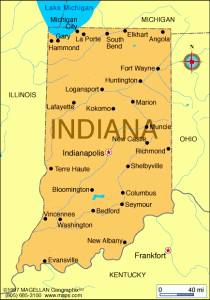
Migration to the state tended to be geographical. Northern Indiana was settled mostly by people from New England. Central Indiana drew people from the mid-Atlantic states and southern Indiana was populated by people from Kentucky, Tennessee and other states in the South.
Manufacturing has always been a major part of the state’s economy. That industry accounts for 27 percent of the state’s total output as well as 17 percent of its workforce. The leading products are vehicles, car parts and pharmaceuticals.
The top livestock product is hogs while the biggest crops are corn and soybeans.
A corner of the state is about to get into the solar energy business in a big way. In October 2021, a ground-breaking ceremony was held for the Mammoth Solar project in Starke and Pulaski counties in the northwest quadrant of Indiana. If completed as planned, the 2,000-acre project with nearly 3 million energy panels would be the largest solar farm in the United States. It’s scheduled to be built in three phases and be fully operational in 2024.
As we continue southward on Interstate 69 through the northeast corner of Indiana, we roll past what used to be nothing but swampland. That’s why this area needed the malaria drugs we mentioned in yesterday’s travels.
The Great Black Swamp was a wetland formed by glaciers in northwest Ohio, southern Michigan and this part of Indiana. The swamp was 40 miles wide by 120 miles long, encompassing 1,500 square miles between Lake Erie and Fort Wayne, Indiana. It consisted of forests and grasslands with thick trees and murky water as deep as chest high.
The swamp was gradually drained in the late 1800s and converted into rich agricultural land. A road was built in 1825 and laid with gravel in 1838. Travel was still rough, though. The region also used to be a mosquito breeding ground.
Today, agricultural runoff from 14,000 farms here has harmed the regional ecosystem and has caused toxic algal blooms in Lake Erie since the 1960s. Climate change is making the blooms more intense.
The algae growths have spurred proposals to return part of the swamp to its natural wetlands state. The Black Swamp Conservancy has led some of the efforts and now oversees 21,000 acres.
Apple Seeds, Circuses and HIV Awareness
An hour after crossing the Indiana border, we reach Fort Wayne.
The city of 270,000 people sits at the confluence of the St. Joseph and St. Mary’s rivers where they form the Maumee River. It’s the second most populous city in Indiana and one with a close connection to the legendary Johnny Appleseed. More on that in a moment.
Native Americans lived in the region for centuries with the area being the capital of the Miami tribe. The first European settlers were French fur traders who arrived in the 1680s. The French built Fort Miami in 1697 as part of a group of forts between St. Louis and Quebec. The British took control of the fort in 1760 but then lost it to native tribes in 1763. The United States captured the fort in 1790 when President George Washington sent in Army troops.
Fort Wayne was built in 1794 and named after Revolutionary War General Anthony Wayne. The town was platted in 1824 and incorporated as a city in 1840.
The Wabash and Erie Canal opened in 1843, bringing growth to the city. The Pittsburg, Fort Worth and Chicago Railway pushed through in 1854. Fort Wayne developed into a manufacturing and distribution center with German and Irish immigrants coming to look for work.
The Horton Manufacturing Company formed in 1871 and by 1924 was producing half of the washing machines sold worldwide. Magnavox moved to Fort Wayne in 1930 and the company’s corporate center is now here.
Lincoln National Life Insurance Company was founded in 1905. The company is now known as the Lincoln Financial Group with its headquarters still in Fort Wayne. Its Lincoln Tower is the tallest building in the city.
In 1983, International Harvester closed its Fort Wayne plant, eliminating 3,000 jobs.

Fort Wayne, Indiana, is where John Chapman, also known as Johnny Appleseed, is buried. Photo by TripAdvisor.
In 1986, General Motors opened the 4.6 million square foot Fort Wayne Assembly Plant in nearby Roanoke. The facility now employs more than 4,000 people and manufactures the GMC Sierra 1500 and the Chevrolet Silverado 1500, among other vehicles. In July 2023, company officials announced they will be investing $632 million into the plant to prepare it for the manufacture of next-generation full-size light duty pick-up trucks.
In 2018, Walmart opened a milk processing plant in Fort Wayne. The facility produces white and chocolate milk for 500 Walmart stores in Indiana, Illinois, Michigan, Ohio and Kentucky. The milk comes from 30 dairy farms within 140 miles of the plant.
Kroger’s and Albertson’s also have their own milk processing plants. Critics say the company plants are producing lower priced milk that is sold as a loss leader. Both Dean Foods and Borden Dairy have filed for bankruptcy, blaming the cheaper milk produced by the stores. We’ll hear more about the struggles of the nation’s $40 billion milk industry when we travel through Wisconsin.
The city began redevelopment efforts in 2000. Recent projects include Promenade Park, The Landing, Boutique Hotel and Electric Works.
Fort Wayne has been the site of a number of famous inventions. They include the washing machine in 1871, the gasoline pump in 1885, the home refrigerator in 1913 and the home video game console by Magnavox in 1972.
Fort Wayne is also known as the final resting place for Johnny Appleseed, who was born John Chapman in 1774 in Massachusetts. Chapman moved to Pennsylvania as a child and planted his first apple tree in 1798.
From there, he traveled west through Ohio, establishing apple orchards and then returning years later to sell the land. Chapman ventured as far west as Illinois and Iowa. He settled in Fort Wayne in 1834.
Most of Chapman’s apples weren’t edible fruit. Instead, they were used to produce hard cider and applejack. He owned 1,200 acres of land at the time of his death in Fort Wayne in 1845.
Chapman was an animal rights activist, a vegetarian in his later years and a follower of the New Church. He spread his faith and staked claims to orchards as he traveled in his threadbare clothing and tin hat while carrying apple seeds in a sack.
Chapman’s grave is at the top of a hill in Johnny Appleseed Park in Fort Wayne. The city also holds a Johnny Appleseed Festival in September.
———————————-
We get off Interstate 69 and head southwest on Highway 24, following the Wabash River to the town of Peru.
This community of 10,000 is a renowned center in the world of circuses, but it also has a connection to one of the country’s most notorious gangsters as well as one of our best known songwriters.
Settlement began when John Holman purchased land from the chief of the Miami tribe in 1827. William Hood then purchased 210 acres from Holman in 1834. Peru was incorporated as a city in 1867.
The Wabash and Erie Canal as well as the railroads helped bring growth.
In the 1880s, local business owner Benjamin Wallace began purchasing defunct circuses at public auctions. He took his circus on the road in 1884.

The International Circus Hall of Fame is in Peru, Indiana. Photo by IndyStar.
Wallace then set up a 220-acre farm outside town for a winter headquarters for his circus. Wallace sold his operation in 1913, but he kept the winter encampment. By the 1920s, the farm had evolved into a winter home for seven major circuses, including the Ringling Brothers Barnum & Bailey operation.
Peru became known as the “Circus Capital of the World.”
The land was eventually sold to Ringling Brothers and it remained a winter headquarters until 1938 where circuses began spending the colder months in Florida.
An International Circus Hall of Fame was established in Sarasota, Florida, in 1959. It closed in 1980. Peru citizens bought the artifacts in 1981. They opened a new circus hall of fame in 1993 at the former Wallace farm. The museum contains wagons, posters and other memorabilia from the glory days of the circus.
There is also a Peru Amateur Circus held in July with 200 performers ranging in age from 7 to 21.
The city also was briefly known for its automobile industry.
In the early 1900s, Peru was home to the Model Automobile Company, which sold a five-seat convertible called The Model. The cars were manufactured in Peru from 1906 to 1909. The company went out of business in 1916.
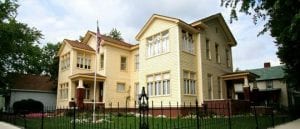
The Cole Porter Inn in Peru, Indiana, is the home where the famous American songwriter grew up. Photo by Atlas Obscura.
Peru nearly lost everything when a massive flood roared through town in 1913 after 8 inches of rain fell in 5 days, causing the Wabash River to overflow. The raging waters killed 11 people as well as some circus animals. Two-thirds of the town was either damaged or destroyed. The loss was estimated at $3 million.
Some businesses left and never returned. The city still has 2,000 fewer people than it did in 1913. In 1969, the Army Corps of Engineers finished dams along the Wabash River to prevent future floods.
Another violent episode in Peru’s history occurred on October 21, 1933.
That’s when John Dillinger and his gang robbed the Peru police station. They seized a Thompson submachine gun, rifles, pistols, a shotgun and bulletproof vests. It was one of four police stations along with 20 banks in the Midwest that the gang robbed.
Dillinger died in 1934 at the age of 31 when FBI agents opened fire on him as he left a theater in Chicago. There’s an exhibit of the Peru police heist at the Miami County Museum in town.
One other landmark in town is the Cole Porter Inn with three suites available for overnight stays. The hotel is named after Cole Porter, the famous songwriter who was born in 1891 in Peru. He spent his early childhood at his family home at 1719 South Huntington Street.
Porter wrote more than 800 songs, mostly for Broadway musicals. He was unable to walk after a 1937 riding accident. He died in 1964 in Santa Monica, California. His grave is at Mount Hope Cemetery in Peru. The family home was converted into the inn.
—————————————
A half-hour south of Peru down Highway 31 is the town of Kokomo.
The city of nearly 60,000 is known for its plethora of inventions but also for a history of intolerance.
The first European settlers arrived shortly before 1840 and named their community after Miami tribal chief Kokomo. The town was laid out in 1844.
The city grew in the mid-1800s with the arrival of railroads that connected it to Indianapolis, Peru and other towns. The discovery of a large natural gas reserve in 1886 produced a flurry of activity for a decade.
The Kokomo Opalescent Glass company opened in 1888 and is still in business.
The horseless carriage industry sprang up in the 1890s.
During World War Two, the automobile parts, machinery and electronics industry were dominant parts of the economy.
Kokomo was hit hard by the 2007 recession. In 2008, Forbes magazine listed it as the third fastest dying town in the country. Since then, Kokomo has revived its manufacturing sector and has been labeled as one of the nation’s “inspirational” towns.
Its years of industry has also produced contamination at several sites.
One of them is the former Continental Steel Corporation factory. The 183-acre facility produced nails, wire and wire fence from scrap steel from 1914 until Continental declared bankruptcy in 1986.
The company disposed of hazardous waste on their property. In 1988, it was declared a Superfund site. The cleanup lasted until 2011. In 2016, the site was approved for use as a solar farm.
In 1995, another pollution problem arose.

Ryan White was attending school in Kokomo, Indiana, when he learned he had contracted AIDS from a blood transfusion. Photo by WFYI.
Officials at the Indiana American Water treatment facility discovered that nearby groundwater had been contaminated. In 2007 and 2011, the water officials reported the discovery of more contamination from wells not owned by the agency.
The site was added to the Superfund list in 2015. Officials at the Environmental Protection Agency are still examining contamination on a 294-acre site with 11 wells known as the Kokomo Wellfield.
The city has also been the center of intolerance during two different periods of the 20th century.
The first was in the 1920s when the Ku Klux Klan held a number of rallies in Kokomo. One of them on July 4, 1923 when 200,000 people gathered in Malfalfa Park for a Konklave in what is believed to be the largest Klan gathering in U.S. history.
The rally raised $50,000 to build a hospital for Klan members so they wouldn’t have to use the local Catholic hospital. The Klan hospital opened in 1925 and closed in 1930.
One historian estimated that in the 1920s half of Kokomo residents were Klan members. Today, the city remains nearly 80 percent white with 10 percent of its residents listed as Black.
The city was in the national spotlight in the 1980s for its reaction to the HIV/AIDS epidemic.
In December 1984, Ryan White, a student at Western Middle School in nearby Russiaville, was diagnosed with AIDS. The youngster had contracted the disease through blood transfusions he received weekly for his hemophilia.
School officials tried to prevent White from attending classes. He was also ostracized by fellow students and was required to use disposal utensils at lunch, drink from a separate water fountain and use a separate restroom.
White’s family received threats and a bullet was fired through a window in their Kokomo home. The family moved in 1987 to Cicero, Indiana, where White was welcomed at the high school there.
White died in 1990 at the age of 18. The media coverage of the Kokomo reaction did help raise awareness of HIV and AIDS. In 1990, Congress approved the Ryan White CARE Act, which funds programs to care for people living with HIV and AIDS.
Kokomo does take pride in its history of inventions.
Among the “firsts” in this town is the first pneumatic rubber tire created by the Kokomo Rubber Tire Company in 1894, the first stainless steel silverware in 1912 and the first canned tomato juice from the Kemp Brothers in 1928.
Kokomo was also the hometown of inventor extraordinaire Elwood Haynes. Among other things, Haynes oversaw the first successful horseless carriage trial run in 1894. He did it using a car that ran on gasoline when most early vehicles used water as fuel.
The Elwood Haynes Museum in the inventors’ old home on Webster Street highlights his life and gadgets. Among the artifacts is a 1905 Haynes Model L car and his Haynes Roadster. His alloys are displayed on the second floor as are some of the town’s other inventions.
For the record, the 1986 Beach Boys song “Kokomo” is not about the Indiana town. It’s about a fictional island in the Caribbean with that name. We’re assuming the group just liked the way the word “Kokomo” sounded in the lyrics.
Racing Toward Indianapolis
Another hour south on Highway 31 takes us to the state capital of Indianapolis.
Right before we get there, we pass through the town of Westfield.
The community of 62,000 was founded in 1834 by North Carolina Quakers, who made it an important stop for fugitive slaves using the Underground Railroad.
The city has grown and annexed land in recent decades. It’s also planning a downtown revitalization.
However, what Westfield is best known for is athletics.
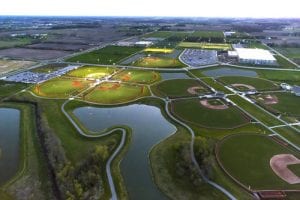
The Grand Park sports complex in Westfield, Indiana. Photo by Team Indiana.
Grand Park here is the largest youth sports campus in the United States. The 400-acre site has 26 baseball and softball diamonds as well as 31 multi-purpose fields for soccer, football, rugby, lacrosse and field hockey. There’s also 10 miles of pedestrian and bicycle trails. In 2016, the park added an indoor sports complex.
Grand Park hosted the USA Archery national championship in 2017. It’s also been the home of the Big 10 men and women soccer tournaments.
In 2018, the Indianapolis Colts signed a 10-year lease to use the park as a training camp.
The park gets 2.5 million visitors in a typical year.
Sports, that of the auto racing kind, is also the claim to fame of our final stop for today.
Indianapolis is the most populous city in the state with more than 870,000 residents. It’s also the fourth most populous state capital, the third most populous Midwestern city behind Chicago and Columbus, Ohio, and the 16th most populous city overall in the United States.
Indianapolis sits along the White River with a layout similar to Washington, D.C.
Native Americans began occupying this region around 2000 B.C. In 1818, the Delaware tribe relinquished their land in the Treaty at St. Mary’s.
In 1821, Indianapolis was founded as a planned city to be the new state’s capital.
The National Road in 1827 as well as the arrival of the railroad in 1847 solidified Indianapolis as a transportation and manufacturing center. It developed the nickname “The Crossroads of America.”
During the Civil War, Indianapolis was a major logistics hub for the Union Army. After the war, it developed into an industrial center with meatpacking and metal working among its chief endeavors. By the 1880s, the city was the world’s third largest pork processing area and the second largest railroad center in the United States.
In the first half of the 1900s, Indianapolis also developed a strong automobile industry. During that time, there were 65 types of vehicles manufactured here.
However, like many cities in the middle of the country, industrial production faded in the second half of the 20th century. Between 1973 and 2006, more than 185,000 manufacturing jobs were lost. Chrysler, Ford and General Motors were among the factories that closed.
In 2016, Carrier company officials announced plans to eliminate 1,400 jobs at its HVAC production plant here as it shifted jobs to Mexico. President Donald Trump visited the factory in early 2017 to announce a tax credit to save those jobs. The program did save some positions, but Carrier still laid off 600 employees over the ensuing year.
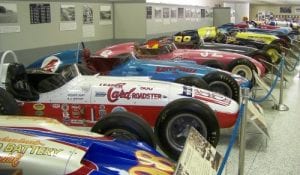
Part of the collection at the Indianapolis Motor Speedway Museum. Photo by Virtual Globetrotting.
The economy in Indianapolis today is more focused on finance, insurance and professional services. Anthem Inc., Eli Lilly and Simon Property Group have headquarters in the city.
The other major component of the economy is sports tourism.
That’s because of the Indianapolis 500 auto race, held during Memorial Day weekend in May.
The race, the world’s largest single-day sporting event in terms of attendance, is held at the Indianapolis Motor Speedway in the center of town. The facility, which seats 250,000 people, opened in 1909 as an auto test track. The first 500-mile race was held in 1911.
The track, known as The Brickyard, is a 2.5-mile oval that drivers circle counter-clockwise at 200 miles per hour.
The race is usually a 33-car field positioned at the start in 3 rows of 11 vehicles each. Some of the traditions include the singing of “Back Home Again in Indiana” and the winner of the race drinking a bottle of milk in the victory circle.
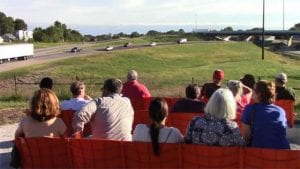
The Idle Park in Indianapolis, where you can sit and watch freeway traffic zoom by. Photo by CBS News.
The history of the race is captured at the Indianapolis Motor Speedway Museum. The 30,000-square-foot facility is located within the Speedway complex. It opened in 1956 and includes 25 winning Indy 500 cars as well as a theater that shows race highlights. The museum temporarily closed its doors in summer 2023 as it began a $89 million renovation. It’s expected to reopen in April 2025.
The other prominent museum in town is the Children’s Museum of Indianapolis, the world’s largest children’s museum. It was founded in 1925. The 815,000-square-foot facility, which features a large dinosaur exhibit, sits on 30 acres. The museum gets more than 1 million visitors in a typical year.
There is an odd place you can also visit while in Indianapolis. The Idle park sits between two freeways near the center of the city. A CBS Sunday Morning report in October 2019 detailed how Tom Battista spent six years getting this little oasis built. The spot sits among bushes on an island between the freeways. Three short rows of stadium seats are there for people to sit and watch all the traffic go by. The park’s name comes from the idling many cars have to do while stuck in jams on the roadways.
One final, more traditional place, you might want to see is the St. Elmo Steak House, which has been open in Indianapolis since 1902. The eatery is best known for its shrimp cocktail and steaks. It also claims to have the world’s “spiciest food.”
The steakhouse was founded by Joe Stahr and named after the patron saint of sailors. It’s a place where the rich and powerful are known to make and sign deals.
We’ll cool our engines here for this segment of our route.
Tomorrow, Day 40 will take us to the town where Abraham Lincoln rose to fame as well as a place known for raising goldfish and another that holds a record for world records.


